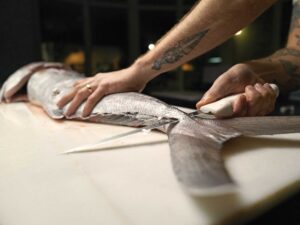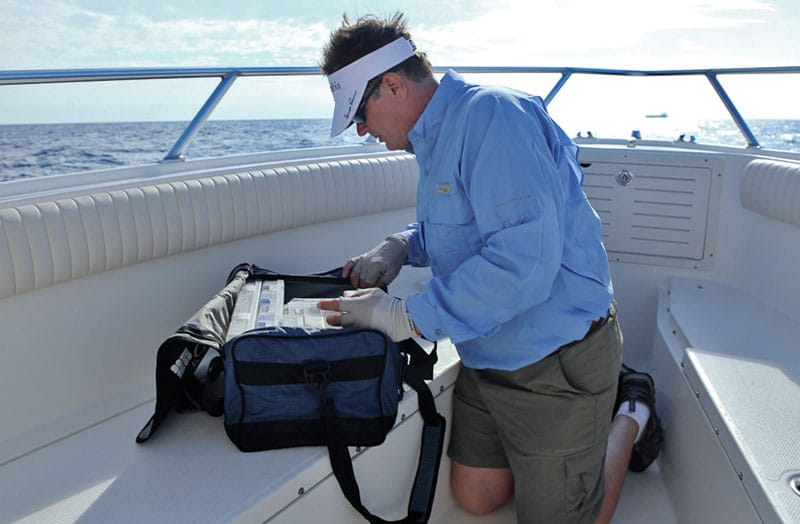
A quick change enabled Carl Grassi and me to convert a trio of amberjack into catches (and releases). We were drifting and fishing jigs and bucktails for groupers on the Abaco, Bahamas, reefs. At around 130 feet, a hump appeared on the fish finder, along with a few marks that weren’t groupers or yellowtails. We took note and repositioned ourselves for another drift.
I went into my tackle bag, opened a plastic compartment, selected a 5-ounce Williamson Benthos jig and replaced the lead-head jig and ballyhoo combo in less than a minute. Grassi repositioned the boat, and we dropped down to enjoy a flurry with those amberjacks. My ability to quickly put my lure of choice into service was the result of having organized tackle boxes. When a situation requires tackle modification, losing time locating that right lure, hook, sinker or swivel has a steep price: a missed opportunity. Anglers need to react to a tackle change as rapidly as an Indy 500 pit crew to servicing a race car. And in the fishing world, efficiency lies in how well those tackle trays are organized.
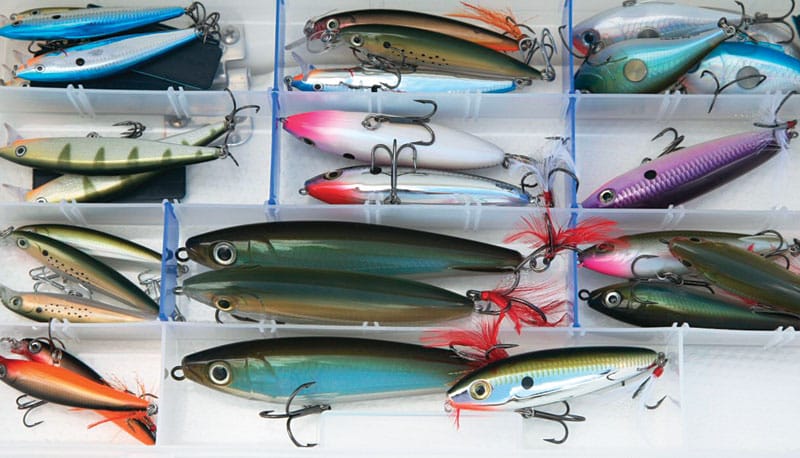
Divide and Conquer
To promote efficiency, I divide my tackle bags and trays according to the type of fishing I plan to do. I have a few offshore bags, a few reef bags and a few inshore bags. Within each tackle bag are plastic tackle trays, with items organized by size, action and even intended species. Take my jigging trays, for example. I have separate trays devoted to bucktails, conventional deep jigs and flutter-style jigs. When Grassi and I got into those amberjacks, I simply opened my reef bag, took out the tray with the larger flutter-style irons and selected my jig. Organizing the jigs, I isolated the casting sizes of both bucktails and flutter-style jigs into separate boxes. Should Spanish or cero mackerel pop up on the reefs, or blackfin tuna and school dolphin offshore, I could easily find bucktails from 116 through 3 ounces in all colors or flutter-style jigs from 1116 through 214 ounces. Again, no rummaging through an assortment of sizes and styles to find the right one.
These bags store neatly in my tackle garage. And this enables me to mix and match certain trays for the fishing I plan on doing. For example, if we want to chum up tuna with live baits and catch them on topwater lures, I’ll make sure to pack my topwater and sinking-lure trays in my offshore bag and leave the trays with offshore-trolling and bait-rigging gear behind. The ability to assemble specific boxes for any specialty fishing is really a neat deal.
Inshore, In-line
Categorizing carries to my inshore lures. For example, I maintain individual trays for topwater, sinking and swimming baits, and also soft baits. Should I desire a topwater lure to pitch at seatrout, snook or tarpon, I retrieve my topwater tray, which contains a few sizes and colors of Rapala Skitter Walks and Skitter Pops and similar-style lures. My sinking-lure trays contain weighted hard baits, like X-Rap SubWalks, Glidin’ Raps and Rattlin’ Rapalas, whereas the swimming tray contains lipped shallow- and deep-diving lures. The soft-plastics trays reveal various sizes and hues of shrimp, crabs and minnow-style bodies. Again, the goal is quick and easy access to the right lures for any situation.
Organization is the same with small terminal items, such as swivels, which are categorized by barrel swivels, three-way swivels and trolling snap swivels in various sizes and strengths. There are also trays specifically for kite-fishing terminal items, such as rubber bands, floats, ceramic rings, release clips, rubber-core sinkers and balloons. The offshore-rigging tray has needles, floss, assorted sleeves, thimbles, crimpers and small sinkers.
Where’s the Hook?
Aboard my boat, the hook trays get the most use. Imagine the range of hook variations needed to cover live- and dead-baiting, from seatrout to swordfish. For rigging trolling baits such as ballyhoo, mullet, mackerel and squid, I have trays with nothing but O’Shaughnessy-style hooks in various strengths and sizes, along with several specialty trolling-style hooks.
The live-bait-style hooks, in-line circle hooks in various strengths from 1/0 through 16/0, are categorized in circle-hook trays. What’s more, the smaller and lighter-wire hooks are confined to one tray, which I use for seatrout on up to sailfish, whereas the heavier-wire and larger circle hooks are in a separate tray, for big grouper on up to yellowfin tuna and sharks. There are also individual trays for J hooks.
When we anchor on the reefs and chum, I remove the trays with the small circle hooks (for yellowtail, muttons, mackerel and kingfish) and also the small bucktails and flutter-style jigs, since this is what we use for the mackerel, amber-jacks and horse-eye jacks. I keep the trays either on or near the console, where we all can work out of them. Before we leave, we return the trays to their respective tackle bags.
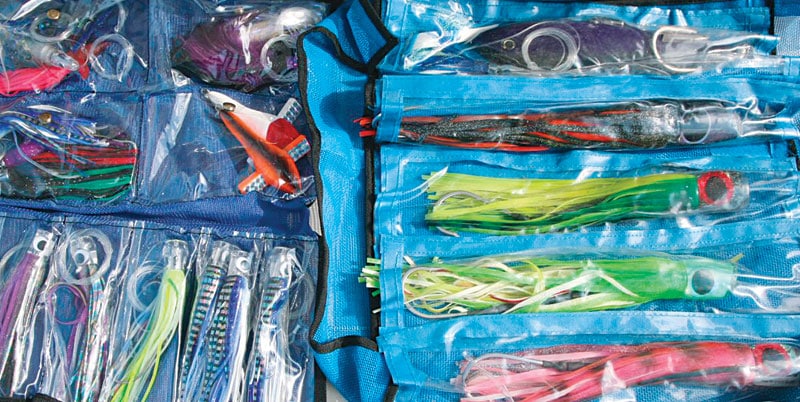
The Offshore Fellas
Offshore trolling lures, while not kept in plastic tackle trays, are organized by size and species sought. They are assigned to lure bags. For example, if we desire to mix some lures into our spread for dolphin, I’ll fetch a lure bag containing small flat-, blunt- and concave-head lures rigged on leaders ranging from 50- to 130-pound-test. Conversely, if we see blackfins or yellowfins, there’s another soft-lure bag with small bullet- and jet-head-style lures rigged on 30- to 80-pound-test fluorocarbon. And of course, we have individual bags with larger marlin lures and wahoo lures.
Container Carl
My friend Carl Grassi is not only a good angler but also meticulous when it comes to storing his tackle. In fact, I recently learned something from him. Rather than keep his accessories, such as knives, leaders and boat parts, on his vessel, he puts them in plastic carry boxes. This way, if he needs fillet knives back at the dock, there’s no rummaging through his boat to find them. He merely goes into his console and retrieves his knife box, where you’ll find several knives, a sharpening stone and even freezer bags for his fillets. What’s neat is that he can wash, dry and oil down these knives before they’re packed away, keeping them clean and rust-free.
I’ve gone this route with my knives, spools of leader material and spare parts (fuel filters and hoses for those Bahamas crossings). It takes just a tad longer to add and remove these containers from the boat, but the advantages include easy access (on the boat and in your garage), less exposure to a saltwater environment and the elements, and a smaller chance of theft if kept permanently on board.
If you’re already taking care of your tackle in this fashion, go to the head of the class; you’re able to concentrate more on catching fish when you’re on the water. If your tackle organization program is running a little behind, remember this article during the next rainy weekend; it will give you plenty to do and something even to curse over if your tackle is really disorganized. But once you’ve arranged everything, there will be a big difference in your efficiency the next time you set forth. And efficiency and preparedness are two classic traits of successful anglers worldwide.
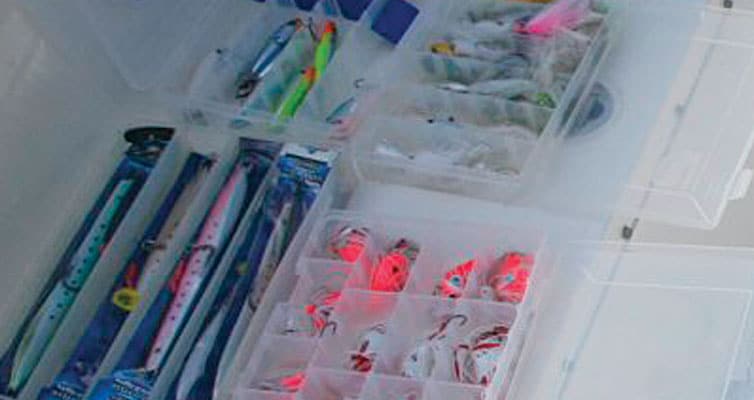
Keep ’em Clean
There are few things I despise more than seeing a used saltwater hook, lure or jig returned to its tray without a freshwater rinse. If you return something without rinsing it, expect rust and corrosion to spread throughout that tray like wildfire, ruining your investment.
On my boat, all used lures, hooks, jigs and such are kept in a bucket or sink until it’s time to wash down the boat. During this process, they’ll get a freshwater rinsing, a soaping and another freshwater rinsing. I hang the gear on a shelf in my garage for several days, and then — and only then — put them back into their respective tackle trays.
Keep ’em Ready to Go
In addition to keeping your terminal tackle organized and readily accessible, it’s smart practice to rig a few extra rods with the lures, jigs and hooks that might come into play during your fishing day. This way, should any opportunities arise beyond your chosen method of fishing that day, you’ll be covered. For example, when trolling offshore, we’ll have several spinners rigged with bucktails and plain hooks. Should we troll up a school of dolphin, we’re set to take advantage of them. Or if we see a large solitary fish, we have the option of pitch-baiting a dead or live bait. There’s also a small conventional outfit rigged with a flutter-style jig, for dropping deep under boards, debris, large weed patches and school dolphin, where wahoo often lurk.



